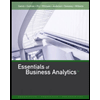
INVESTMENTS(LL)W/CONNECT
11th Edition
ISBN: 9781260433920
Author: Bodie
Publisher: McGraw-Hill Publishing Co.
expand_more
expand_more
format_list_bulleted
Question
Chapter 12, Problem 22PS
Summary Introduction
To compute:
The change from last year to current year in the confidence index
Introduction:
Confidence index reflects the faith of investor in the security market and the economy. A deteriorating or low confidence index is considered as a bearish sign by the technical analyst. On the other hand A high or increasing level of confidence index is considered as a bullish sign by technical analyst.
Expert Solution & Answer
Want to see the full answer?
Check out a sample textbook solution
Students have asked these similar questions
Dear tutor finan
Need soln
Dear tutor solve ..
Chapter 12 Solutions
INVESTMENTS(LL)W/CONNECT
Ch. 12 - Prob. 1PSCh. 12 - Prob. 2PSCh. 12 - Prob. 3PSCh. 12 - Prob. 4PSCh. 12 - Prob. 5PSCh. 12 - Prob. 6PSCh. 12 - Prob. 7PSCh. 12 - Prob. 8PSCh. 12 - Prob. 9PSCh. 12 - Prob. 10PS
Ch. 12 - Prob. 11PSCh. 12 - Prob. 12PSCh. 12 - Prob. 13PSCh. 12 - Prob. 14PSCh. 12 - Prob. 15PSCh. 12 - Prob. 16PSCh. 12 - Prob. 17PSCh. 12 - Prob. 18PSCh. 12 - Prob. 19PSCh. 12 - Prob. 20PSCh. 12 - Prob. 21PSCh. 12 - Prob. 22PSCh. 12 - Prob. 23PSCh. 12 - Prob. 24PSCh. 12 - Prob. 25PSCh. 12 - Prob. 1CPCh. 12 - Prob. 2CPCh. 12 - Prob. 3CPCh. 12 - Prob. 4CPCh. 12 - Prob. 5CP
Knowledge Booster
Learn more about
Need a deep-dive on the concept behind this application? Look no further. Learn more about this topic, finance and related others by exploring similar questions and additional content below.Similar questions
- solve this problem qn ??arrow_forwardWhich of the following is not an investment grade credit rating?* BB+ BBB+ BBB BBB-arrow_forwardCompany A has a capital structure of $80M debt and $20M equity. This year, the company reported a net income of $17M. What is Company A's return on equity?* 117.6% 21.3% 85.0% 28.3%arrow_forward
- 12. Which of the following is the formula to calculate cost of capital?* Total assets/Net debt x Cost of debt + Total assets/Equity x Cost of equity Net debt/Equity x Cost of debt + Equity/Net debt x Cost of equity Net debt x Cost of debt + Equity x Cost of equity Net debt/Total assets x Cost of debt + Equity/Total assets x Cost of equity .arrow_forwardno ai .What is the enterprise value of a business?* The market value of equity of the business The book value of equity of the business The entire value of the business without giving consideration to its capital structure The entire value of the business considering its capital structurearrow_forward10. The concept of time value of money is that* The cash flows that occur earlier are more valuable than cash flows that occur later The cash flows that occur earlier are less valuable than cash flows that occur later The longer the time cash flows are invested, the more valuable they are in the future The future value of cash flows are always higher than the present value of the cash flows .arrow_forward
- 9. Which of the following is true when a bond is trading at a discount?* Coupon Rate > Current Yield > Yield to Maturity Coupon Rate < Current Yield < Yield to Maturity Coupon Rate = Current Yield = Yield to Maturity Coupon Rate < Current Yield = Yield to Maturity.arrow_forwardWhen the price of a bond is above the face value, the bond is said to be* Trading at par Trading at a premium Trading at a discount Trading below pararrow_forward7. What is a par value of a bond?* The amount borrowed by the issuer of the bond and returned to the investors when the bond matures The overall return earned by the bond investor when the bond matures The difference between the amount borrowed by the issuer of bond and the amount returned to investors at maturity The size of the coupon investors receive on an annual basisarrow_forward
- What is an annuity?* An investment that has no definite end and a stream of cash payments that continues forever A stream of cash flows that start one year from today and continue while growing by a constant growth rate A series of equal payments at equal time periods and guaranteed for a fixed number of years A series of unequal payments at equal time periods which are guaranteed for a fixed number of yearsarrow_forwardIf you were able to earn interest at 3% and you started with $100, how much would you have after 3 years?* $91.51 $109.27 $291.26 $103.00arrow_forwardNo AI 2. The formula for calculating future value (FV) is* FV = PV/(1+r)^n FV = PV/(1+r)*n FV = PV x (1+r)^n FV = PV x (1+r)*narrow_forward
arrow_back_ios
SEE MORE QUESTIONS
arrow_forward_ios
Recommended textbooks for you
 Essentials of Business Analytics (MindTap Course ...StatisticsISBN:9781305627734Author:Jeffrey D. Camm, James J. Cochran, Michael J. Fry, Jeffrey W. Ohlmann, David R. AndersonPublisher:Cengage Learning
Essentials of Business Analytics (MindTap Course ...StatisticsISBN:9781305627734Author:Jeffrey D. Camm, James J. Cochran, Michael J. Fry, Jeffrey W. Ohlmann, David R. AndersonPublisher:Cengage Learning Intermediate Financial Management (MindTap Course...FinanceISBN:9781337395083Author:Eugene F. Brigham, Phillip R. DavesPublisher:Cengage Learning
Intermediate Financial Management (MindTap Course...FinanceISBN:9781337395083Author:Eugene F. Brigham, Phillip R. DavesPublisher:Cengage Learning


Essentials of Business Analytics (MindTap Course ...
Statistics
ISBN:9781305627734
Author:Jeffrey D. Camm, James J. Cochran, Michael J. Fry, Jeffrey W. Ohlmann, David R. Anderson
Publisher:Cengage Learning

Intermediate Financial Management (MindTap Course...
Finance
ISBN:9781337395083
Author:Eugene F. Brigham, Phillip R. Daves
Publisher:Cengage Learning

Dividend explained; Author: The Finance Storyteller;https://www.youtube.com/watch?v=Wy7R-Gqfb6c;License: Standard Youtube License